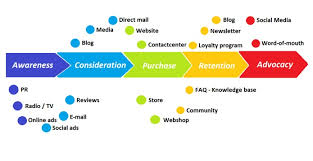Use Conversion Funnels to Optimise how you turn visitors into customers
Most businesses are multi-channel and the customer is observing or engaging with your business in many ways, often without your awareness. All these touch points are relevant not only the online touch-points and certainly it would be a mistake to assume that only the touch-points identified in your conversion funnels are important.
In reality the user journey is often complex and can include numerous visits all of which can have major impact on the outcome. A funnel is representative of key milestones in the journey where the actions of the user suggest strongly that they have transitioned to a more advanced stage in the conversion journey.

Funnels are normally dynamic representations of these points in the journey or events that are described via data available typically from the analytics system though often enriched with data from CRM. Tools such as the Google Analytics suite of tools support creation of events, recording them and representing that event data visually as a funnel. For more advanced users it is also relatively straightforward and eminently more useful to capture this data via the API and build your own live funnel in Excel or Google sheets where you can watch it move, see the conversion rates change and calculate what-if scenarios to quickly discover the ROI of improving a particular metric.
Begin with a simple sketching tool and draw your events as boxes joined by lines to represent a simplified journey. Do any research you can to confirm your assumptions about these events. For example you may measure the likelihood of purchase for someone at this stage of the journey as opposed to someone at the previous stage. You might also serve a poll with a single question at specific points on the site and collect responses that build a picture. The more you use and test the conversion funnel the more valuable it will become as you confirm or adjust your hypothesis.

To the left is a classic CRM type of funnel and a very useful one where a salesforce and a marketing team agree the classification of a lead and an opportunity and there is a well understood vocabulary and obviously a good understanding of the expected value of the funnel at different points. There is no right or wrong definition, but consistency is vital and how you respond is vital.
Download free guide to funnels
When you understand your customers well enough to identify their feelings and emotions and define a full user journey for the events online and begin to base your funnel on key emotional touch-points in this realistic user journey, then your content will improve dramatically and you will see major improvements in your conversion rates.
Even creating a simple funnel based on AIDA Awareness, Interest, Desire Action can bring a whole new meaning to eCommerce or conversion strategy and improve your content creation.
We can help you in many ways with your conversion journey from customer research to getting all the data you need into one place, or defining and setting up goals and funnels and helping define and refine a strategy.

Recent research shows that for every£1 spent globally on Conversion Rate Optimisation, £72.00 are spent on advertising.
Investment in converting your visitors is by far the biggest opportunity available to marketers today and with advertising costs rising rapidly, it has become a necessity for top businesses.
The typical functions of an automated Marketing CRO system
- Visual Form builder including modal popup forms.
- Form integration with other systems like CRM
- Automated mailing campaigns with complex rules.
- Ability to send notifications, tweets, Messenger messages.
- Visual Landing Page builder.
- Storage and management of downloadable assets.
- Create a customised funnel process.
- Tag users as they view pages or click links and buttons to create progressive profiles.
- Segment based on profiles, geography and other data.
- Complex rules to add or remove users from campaigns and mailing lists.
- Ability to run multiple a/b tests on every node from form to landing page and email to optimise the journey.
- Simple to add UTM tags for tracking Facebook and Google advert conversions.
- Landing pages can be customised based on passed in search terms from Google etc.
Costs for CRO systems and Marketing platforms.
The leaders in the industry are Hubspot and Salesforce but it is the fastest growing area of technology right now. It takes very close inspection. Apart from the very different features available in each, the pricing models can be hard to compare but typically the cost will run to £800 per month and upwards once you have any sort of realistic campaigns running.
Typically you will require a setup package costing in the region of £2000 but could be any size depending on complexity to get you through the strategic side of planning your campaigns well for success and then the fairly complex business of setting up the tools, creating themes, customising forms, landing pages and emails and so forth.
We can help you with selection and setting up of an appropriate system.
We specialise in Mautic Open Source which has the benefit of mo ongoing monthly costs. We offer setup packages comparable to the other players ad annual maintenance and support packages that make it very good value.
Returns
Once running and refined from testing and experience, you could easily recoup your enitre setup costs every month and even more.
